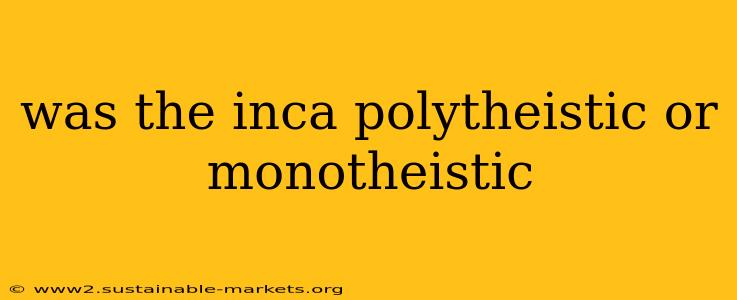The Inca religion is often described as polytheistic, but a nuanced understanding reveals a more complex spiritual system than a simple "many gods" label suggests. While they worshipped a pantheon of deities, the Inca worldview held a unique hierarchical structure and underlying principles that defy easy categorization. This exploration will delve into the complexities of Inca religion, examining the evidence and arguments surrounding its polytheistic nature, while acknowledging the subtleties that complicate a straightforward answer.
The Inca Pantheon: A Hierarchy of Deities
The Inca worshipped a vast array of gods and goddesses, each associated with specific aspects of nature, human activities, and the cosmos. These deities weren't simply independent entities; they were interconnected within a complex hierarchy. At the apex resided Viracocha, the creator god, often considered the most powerful deity. However, Viracocha's role wasn't always strictly defined as a singular, all-powerful god in the way monotheistic religions conceive of a supreme being. His creation myth varied regionally, sometimes even depicting him creating other gods.
Other significant deities included Inti (the sun god), Mama Killa (the moon goddess), and Pachamama (Mother Earth). These deities held immense importance, with elaborate ceremonies and rituals dedicated to them. Regional deities and local spirits (huacas) also held significant sway in the daily lives of the Inca people. This complex web of deities highlights the polytheistic nature of Inca religion.
Inti: The Sun God's Prominence
While Viracocha held a position of ultimate creation, the sun god Inti held a particularly prominent role in Inca daily life and imperial ideology. Inti was considered the ancestor of the Sapa Inca (emperor), lending a direct connection between the divine and the ruling class. This close association elevated Inti's status, blurring the lines of a strictly hierarchical pantheon. The emphasis on Inti's worship, however, does not equate to monotheism.
The Concept of Viracocha: Creator and Beyond
The role of Viracocha complicates the "polytheistic/monotheistic" dichotomy. While creating other deities, he also represented a cosmic force, a source of all creation. Some interpretations suggest that Viracocha's role transcended the typical understanding of a god, representing a more abstract concept of the divine source of existence. This nuanced understanding challenges the simple classification of Inca religion.
Huacas: Local Spirits and the Complexity of Worship
The Inca worldview also incorporated a vast array of huacas. These were revered natural features, such as mountains, rocks, springs, and even caves, believed to possess supernatural power. Each huaca had its own unique characteristics and significance, reflecting the local environment and beliefs. The worship of these local spirits adds another layer to the complexity of Inca religious practices, further underscoring the polytheistic aspects of their faith.
Conclusion: A Polytheistic System with Nuances
In conclusion, while the Inca pantheon included numerous gods and goddesses, along with venerated huacas, describing their religion as simply "polytheistic" lacks the necessary nuance. The hierarchical structure of their deities, the ambiguous role of Viracocha, and the incorporation of local spirits demonstrate a more intricate and layered spiritual system. While undeniably polytheistic, the Inca religious landscape invites a deeper understanding of Andean spirituality beyond the simplistic labels often applied. Further research and exploration are necessary to appreciate the full complexity and richness of this fascinating ancient culture.

